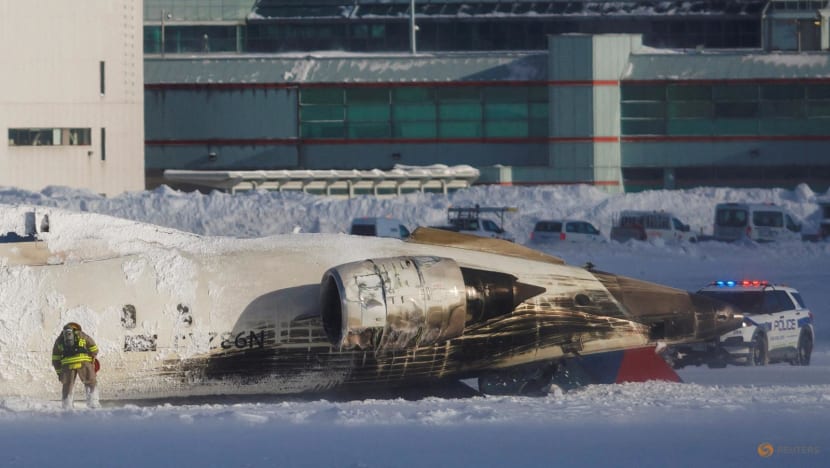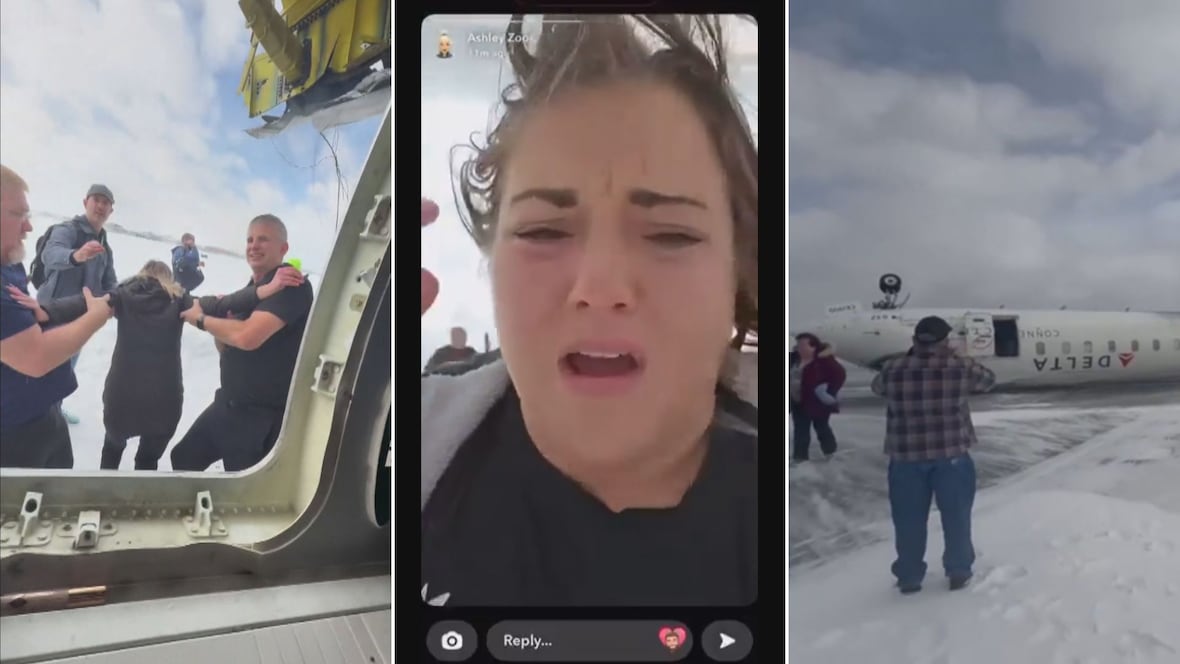A tragic aviation accident occurred at Toronto Pearson International Airport, Canada, when a Delta Air Lines aircraft crashed and overturned while attempting to land. The incident resulted in critical injuries to three individuals, including a child, and left numerous others requiring medical attention. Emergency responders quickly arrived at the scene, working diligently to rescue and treat those on board.
Details of the Crash
According to reports, the aircraft involved in the crash was Delta Air Lines Flight 4819, operated by Endeavor Air, a subsidiary of Delta. The plane, identified as a CRJ900, was arriving from Minneapolis and carried a total of 80 people—76 passengers and four crew members. At approximately 14:15 ET (19:15 GMT) on Monday, the aircraft experienced difficulties while landing, ultimately flipping over and coming to a stop upside down on the snow-covered runway.
Images and videos shared on social media captured the shocking aftermath of the crash. The aircraft appeared to have sustained severe damage, with at least one wing missing and its fuselage lying overturned on the icy tarmac. Footage showed passengers scrambling to exit the wreckage while emergency crews rushed to contain the situation.

Emergency Response and Injuries
The emergency response was swift and well-coordinated. Ontario’s air ambulance service, Ornge, deployed three air ambulances and two land ambulances to transport the injured to hospitals. In total, 18 individuals were hospitalized, with three in critical condition—a child, a man in his 60s, and a woman in her 40s.
Despite the severity of the crash, officials credited the rapid response of emergency personnel for preventing loss of life. Toronto Pearson Airport President and CEO Deborah Flint described the emergency reaction as “textbook,” highlighting the efficiency and professionalism of first responders.

Investigation and Cause of the Incident
Authorities have launched an investigation to determine the cause of the accident. The Transportation Safety Board of Canada (TSB) is leading the probe, deploying a team to gather evidence and assess the situation. Early reports suggest that the runway was dry and that wind conditions were not a contributing factor, contradicting initial claims of strong gusts exceeding 40 mph (64 km/h).
Video evidence and eyewitness accounts indicate that passengers managed to evacuate the aircraft before emergency teams arrived. One passenger recorded a video while escaping the wreckage, stating, “We’re in Toronto, we just landed. Our plane crashed, it’s upside down.” The footage showed passengers helping one another out of the plane while fire crews sprayed foam to prevent a fire outbreak.

Impact on Airport Operations
Following the crash, Toronto Pearson International Airport temporarily suspended all flight operations. Arrivals and departures were halted as emergency teams worked to secure the scene and assist passengers. By 17:00 local time, the airport resumed operations, though two runways remained closed for further investigation. Authorities warned travelers to expect delays in the coming days as flight schedules were adjusted.
Several passengers reported that their travel plans were severely disrupted. Many were left stranded in Toronto, unable to find alternative flights due to cancellations and overbookings. James and Andrea Turner, a couple traveling through Pearson Airport, described the chaos they witnessed: “They got rid of everybody from customs to security, and then put everybody back to the general area. The departures hall was packed.”
Weather Conditions and Recent Disruptions
The crash came amid a period of severe weather disruptions at Toronto Pearson Airport. Over the previous week, the region had been experiencing heavy snowfall and freezing temperatures. Two major snowstorms had dumped between 30 to 50 cm (11.8 to 19.6 inches) of snow, leading to widespread travel delays. On the morning of the crash, the airport had warned travelers of frigid temperatures and high winds, although it remains unclear whether these conditions played a role in the accident.
CBS, a partner of the BBC, reported that light snow was falling at the time of the crash. However, aviation experts have yet to determine whether the weather conditions contributed to the incident.
Reactions from Officials and the Public
The crash drew immediate attention from Canadian and U.S. officials. Ontario Premier Doug Ford stated that provincial authorities were in close communication with airport officials and emergency responders, offering assistance as needed. Minnesota Governor Tim Walz also expressed his concern, commending the efforts of first responders who acted swiftly to contain the situation.
For many travelers, the incident served as a stark reminder of the potential dangers of air travel, particularly during adverse weather conditions. While aviation accidents are rare, the dramatic nature of the crash left a significant impact on those who witnessed or experienced it firsthand.
Comparisons to Other Recent Aviation Incidents
This crash is one of several significant aviation incidents in North America within the past month. Notably, a deadly mid-air collision between a passenger plane and a military helicopter near Washington D.C.’s Ronald Reagan Airport claimed the lives of all 67 people on board. The Toronto Pearson crash, while not fatal, underscores the ongoing safety challenges faced by the aviation industry.
Delta Air Lines’ Response
In the wake of the crash, Delta Air Lines issued a statement confirming the involvement of Flight 4819 and emphasizing its commitment to supporting affected passengers. The airline assured the public that it was cooperating fully with investigators and focusing on the well-being of those impacted.
Delta stated, “Our primary focus is taking care of those affected by this incident. We are working closely with local authorities and emergency services to ensure the safety and recovery of our passengers and crew.”
Additionally, Toronto Pearson Airport management has vowed to implement any necessary safety improvements based on the findings of the investigation.
Conclusion
The crash of Delta Air Lines Flight 4819 at Toronto Pearson International Airport is a sobering event that has left several passengers injured and disrupted countless travel plans. While no fatalities were reported, the incident has raised concerns about airport safety, emergency response protocols, and the potential impact of weather on flight operations.
As investigators continue their analysis, passengers and airline officials alike will be looking for answers to prevent similar occurrences in the future. In the meantime, the resilience of emergency responders and the coordination of aviation authorities have been instrumental in ensuring the safety of those on board. The coming days will reveal further insights into the causes of the crash and the steps needed to enhance air travel security moving forward.

